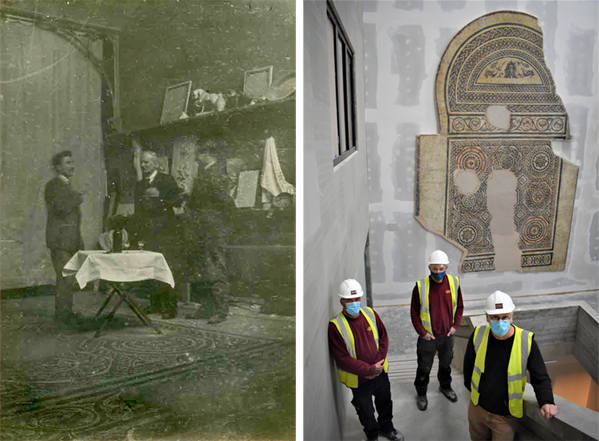News
Conservators re-install Mosaic in Museum
December 2, 2020
Over a year after it was lifted to begin construction for the £16 million re-development of Dorset Museum, this 2nd-century Roman mosaic has been reinstalled in the Museum’s new atrium stairwell.
The team involved in this project have celebrated this momentous occasion by recreating a 93-year-old photograph that was taken to mark the first laying of the mosaic in the Museum in 1927.
First uncovered at the Lott and Walne Foundry, Dorchester, in 1903 and then rediscovered in October 1927, the mosaic was presented to the museum by the Proprietors J. J. Walne and O.C. Vidler in November 1927. A committee group was formed to preserve the mosaic and to save it by relocating it. Thomas Hardy was among the group who assisted in the removal and relaying of the mosaic at the Museum and helped them to engage two mosaic pavement artists Giomeria Zanetter and Sidney Smith from the Cristofoli Mosaic Works, Bournemouth, to undertake the work.
Measuring 7.15m x 4.8m this Romano-British pavement mosaic’s design consists of a head of Neptune, two dolphins and red-finned fish; it is almost identical to pavements of a similar date found at Bignor and Cirencester.

In the original photograph from our archive, we see pictured the two mosaicists Giomeria Zanetter (left) and Sidney Smith (right) with Curator, Captain John Edward Acland in the middle, celebrating the final completion of the laying of the mosaic on 5th December 1927. In the new photograph, you can see the team from Cliveden Conservation – Lee Kimber is on the left, Richard Ball in the centre, and Brian Bentley standing in the stairwell of the new Atrium, with the newly installed mosaic behind them.
The mosaic has been repositioned and installed in the redeveloped Museum by the expert team from Cliveden Conservation who have been conserving the mosaic and bringing it back to its former glory. Supporters of this conservation project include the Roberts Charitable Trust and the Art Fund, which donated £45,000 through their Conservation Grant scheme.
Important Announcement
The lift in the Museum is currently out of action.
We hope to resolve this very soon and apologies for the inconvenience.